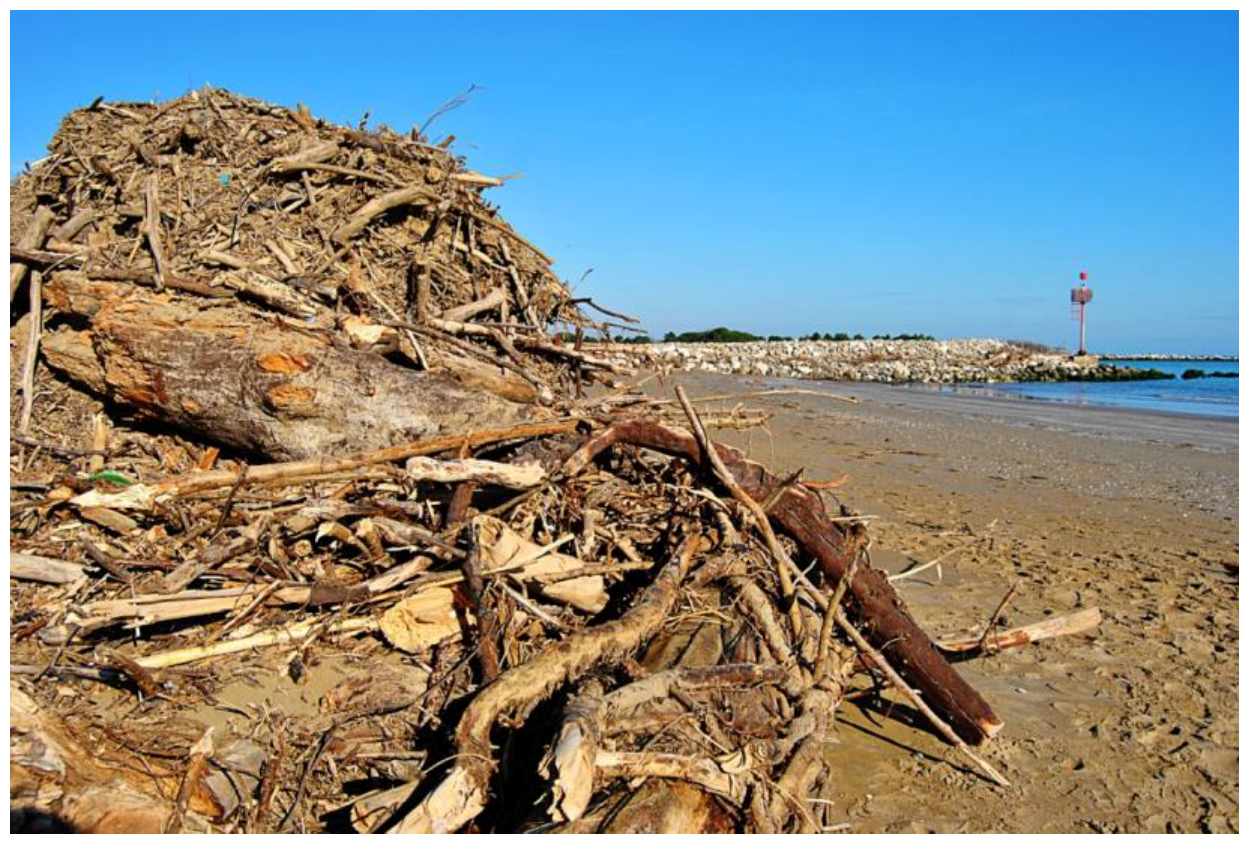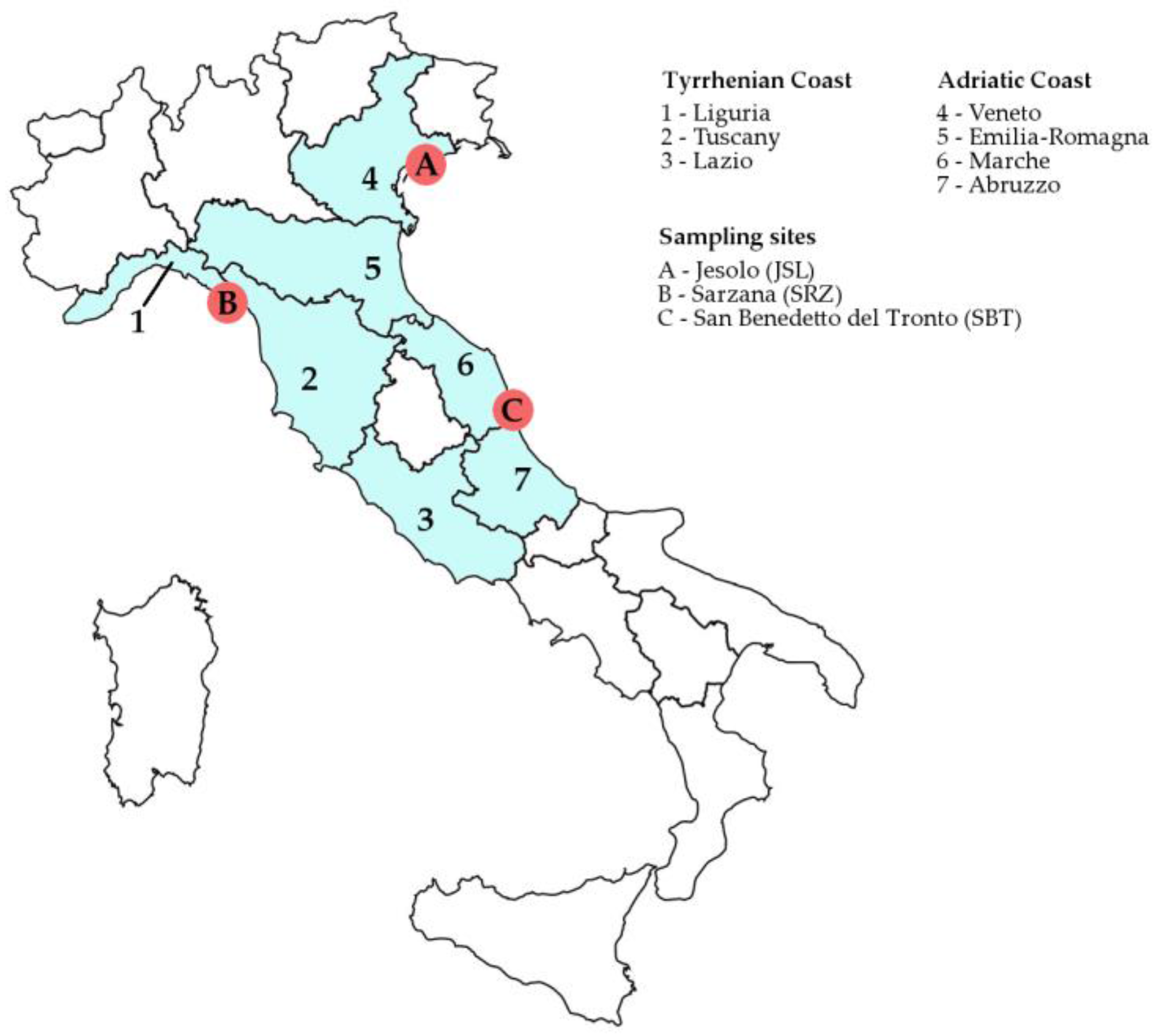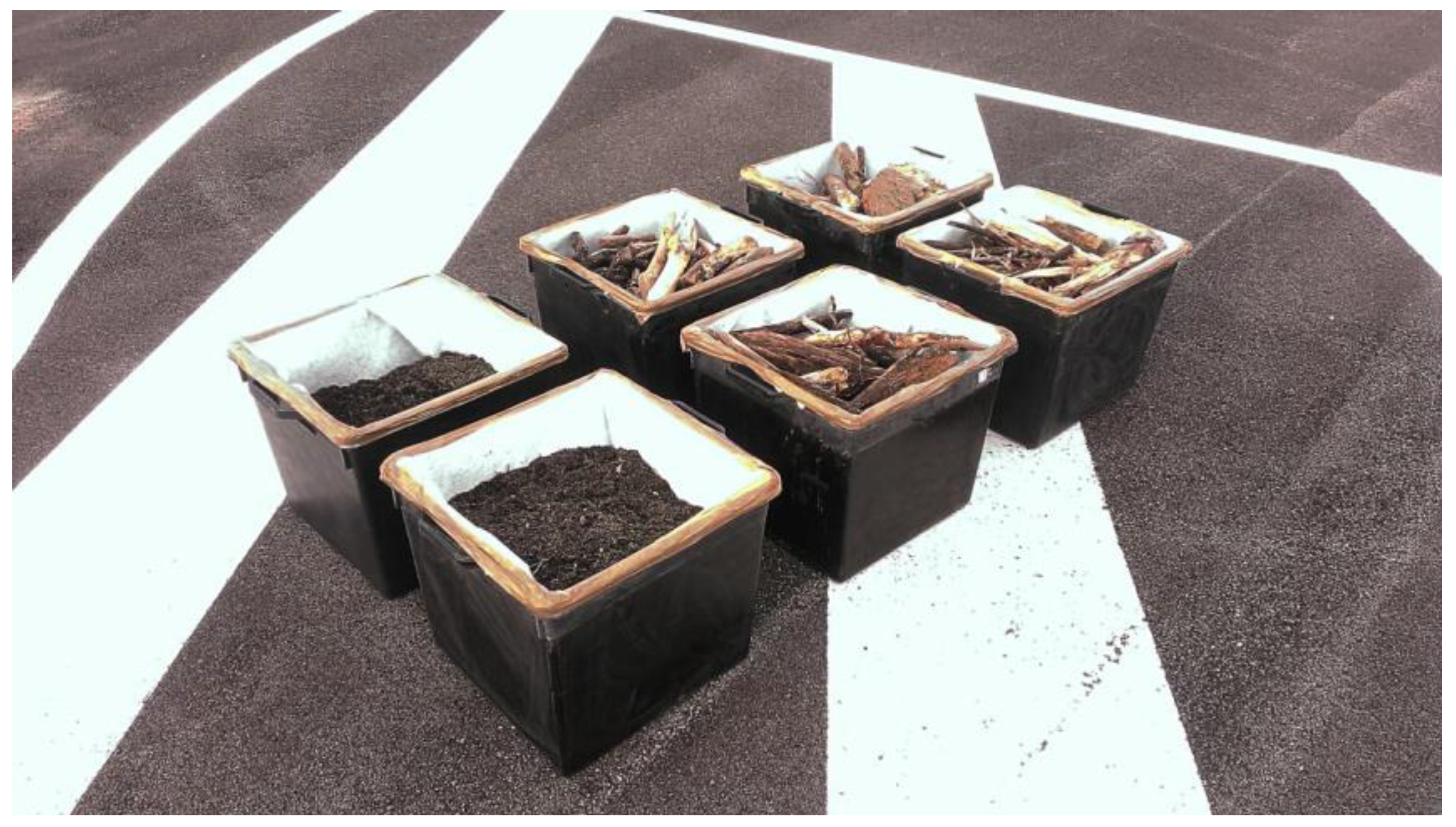3.1. Driftwood Availability
More than 60% of municipalities to which questionnaires were sent replied; the data provided were statistically aggregated at the regional level, as reported in
Table 3.
Results show that more than 60,000 tons of driftwood accumulates every year on the central and northern Italian coastline. This phenomenon involves large treatment costs, due also to its influence on the local economies, strongly based on fishing and tourism. Local administrations’ expenditure is estimated at around 7.3 million euros per year.
In particular, the Regions most affected by biomass accumulation on seashore are Liguria and Veneto, with about 15.3 and 12.6 thousands of tons per year, respectively.
In Italy, driftwood is classified as municipal solid waste, but no specific guidelines have yet been issued regarding the procedures for its collection and treatment; so, each municipality has its own management system, mostly based on the collection and landfill disposal or on-site incineration of driftwood. The first approach is characterized by high management costs: from the survey campaign, the average cost for driftwood management is estimated at 120 €/ton.
The main environmental issue is that landfilling not only takes up more and more valuable land space, but it also causes air, water, and soil pollution, discharging methane into the atmosphere and chemicals into the earth and groundwater. In particular, the European Commission adopted a legislative proposal and annex to review waste-related targets in the Landfill Directive 1999/31/EC as well as recycling and other waste-related targets in the EU Waste Framework Directive 2008/98/EC [
20,
21].
3.2. Chemical–Physical Properties of Driftwood
Driftwood collected in the three chosen sites had the size ranges and the sand contents shown in
Table 4. Samples from Sarzana and Jesolo had medium and large dimensions and low sand content, while those from San Benedetto del Tronto had small dimensions and a sand content of about 50%. Results of the characterization analysis are summarized in
Table 5,
Table 6 and
Table 7.
Data highlight the differences between two groups of samples: SRZ.C1, SRZ.C2, JSL.C1, JSL.C2, on the one hand, and SRZ.C3 and SBT.C3, on the other hand.
The latter present high ash content (up to 24.35%), low LHV (less than 14 MJ/kg), C/N ratio lower than 30 in the case of SBT.C3, or 40 in the case of SRZ.C3, and considerable concentrations of some relevant major elements (calcium, sodium, magnesium, potassium, sulphur, and chlorine). Driftwood with these characteristics is not suitable for combustion. Samples of the first group have good LHV values (16.5–19.0 MJ/kg) and high C/N ratios (up to 85) in the case of SRZ.C1; therefore, they might seem potentially suitable for combustion. These values are in line with those of a typical biomass used as woodchip in an energy plant [
22]. Thus, assuming the energy recovery of the C1 fraction of driftwood and an average moisture content of 40%, the overall energy potential from driftwood in Liguria and Veneto regions is equal to about 166 TJ/year and 144 TJ/year, respectively.
However high concentrations of major elements and considerable ash content were recorded. In the light of these data, it seems clear that contact with seawater and sand on the shore significantly influenced the salinity level and the ash content of the material.
3.3. Effect of Washing on Driftwood Properties
SRZ.C1 and JSL.C1 samples were subjected to natural rain washing. Test duration was 30 days, in which Perugia had 123 mm of rain.
At the end of the test, the material was air dried and then characterized in order to make a comparison between washed and unwashed biomass. It is important to mention that degradation by atmospheric agents decreased the dry matter content by around 30%. Results are shown in
Table 8,
Table 9 and
Table 10. Thermogravimetric analysis highlighted a decrease around 45% in ash content and a slight drop of LHV (about 10%). Significant variations of C/N ratio were not found.
A remarkable reduction of almost all the major elements investigated was observed. In particular, the best reduction indexes (IR) were reported for chlorine and sulphur, with values up to 93.06% and 95.83%, respectively. This is an important result because burning driftwood can produce polychlorinated dibenzo-p-dioxins and polychlorinated dibenzo-p-furans (PCDD/F). As shown by [
5], the increase of fuel matrix chlorine from 0.04% to 0.8% can result in about a 100-fold increase of PCDD/F.
Values of alkali index, fouling index, slagging index, and slag viscosity index before and after the rainfall washing treatment are summarized in
Table 11.
After washing treatment, the indexes of the samples collected in Jesolo showed better values than those of untreated samples. Nevertheless, they still have values typical of a material not suitable for combustion process. In particular, AI and FI, with 0.39 kg/GJ and 1.32, respectively, show an undesirable fouling inclination. This would cause deposits in the combustion chamber with a consequent decrease of efficiency. SI and SVI gave conflicting information on slagging inclination, with a good 0.008 and a poor 18.15, respectively. The best results were obtained for the samples collected in Sarzana: AI and FI showed a minimal fouling inclination, with values comparable to a commercial solid fuel. However, as for Jesolo, SI and SVI gave conflicting information on slagging inclination, with an excellent 0.0001 and a mediocre 18.15, respectively.
In the literature, there are several studies concerned with leaching or washing of biomass [
23], mainly regarding agricultural residues, such as sorghum [
24], corn, and cotton stalks [
25]. The main aim of the previous works was to tackle the deposition and corrosion problems during combustion by pretreating biomass via washing. However, only Jenkins et al. [
26] evaluated the effectiveness of natural rain washing for the improvement of the combustion properties of biomass. They analysed rain-washed rice straw after 65 mm of cumulative rain fall, obtaining a reduction of the ash content equal to 4.2%. Regarding chlorine and sulphur, the washing treatment led to a decrease of 92% and 33%, respectively. Furthermore, the silica concentration of ash substantially increased (about 23%), and appeared to be relatively inert, confirming the results observed in our study. In this regard, Gudka et al. [
23] suggested that the solubility of SiO
2 is improved with hot water.
3.4. Washing Water Properties
Results of characterization of the washing water are reported in
Table 12.
Higher values were observed in the washing water of San Benedetto del Tronto, except for COD, iron, and silicon content. This is probably due to the smaller material size, which favoured the removal action of rain water.
However, in all examined cases, extremely high values of both chemical oxygen demand and major element concentrations were reported. Furthermore, the recorded salinity level was also remarkable and it could represent an environmental problem if the washing water is discharged into freshwater systems without any pretreatment. In fact, salinization of rivers and streams has lethal effects on aquatic life [
27]; an electrical conductivity of 2 mS/cm can be suitable for drinking and irrigation but could have toxic effects on many freshwater insect species [
28]. Therefore, the best solution could be to carry out the washing treatment along the coastline, in order to discharge the washing water directly into the sea. Otherwise, it would be necessary to install a proper washing water treatment, in order to avoid contamination of soil and groundwater.














